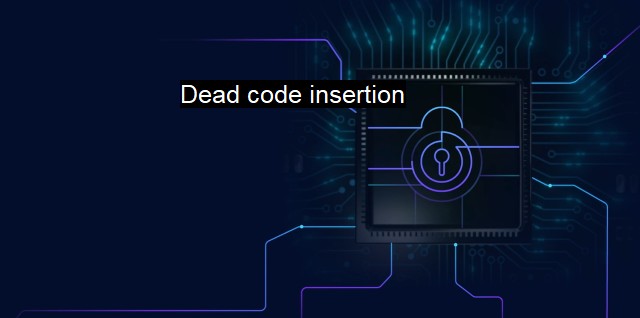What is Dead code insertion?
Understanding Dead Code Insertion as a Crucial Technique for Fortifying Software Security Against Cyber Threats
Dead code insertion can be understood as a method applied in programming to confuse, mislead, or throw off anyone attempting to reverse-engineer the code. This method is often employed by malware creators to conceal malicious routines and hooks by maintaining a facade of innocuous codes. Unsuspicious in their appearance, these sections of code may go ahead uncensored by antivirus systems and cyber defenders' scrutiny and make the malware more challenging to identify and analyze.Foregrounding the notion of "dead code," it is essentially a chunk of code inserted into the system that's not get run. This hidden functionality could potentially be filled with benign or harmful behavior, but as long as it's unreachable by the regular code-flow, it remains perceptive to behold but difficult to discern. This inconspicuous allocation of randomly dispersed snippets of code makes them especially difficult to isolate. The concept mostly finds precedence in diverting the potency of a static analysis tool, which is used for investigating the potential vulnerabilities by examining the source code we are dealing with.
Speaking from a cybersecurity context, it’s akin to a scenario where a decoy or trap is set up laced with secret elements to distort the suspected attacker’s attention. Otherwise useful codes become “dead” as they are strategically replaced or sprawled all over the malicious code, giving an impression of an ungainly layout, which makes it difficult for an outsider to make sense of what is going on. This trespasser will find difficulty in narrowing down precisely which parts of the code have malicious intent and which parts are benign, hence making the detecting scanner pass over the segments inconsequentially.
As for the antivirus realm, dead code insertion has been a long-standing challenge. This is chiefly because most traditional antivirus software only scans the code that is actively up for execution. Misreading or overlooking the potentially harmful elements sealed in the dead codes, the antivirus software may prove inadequate in addressing or mitigating the lurking security threats. This failure of detections compromises the overall efficiency of the antivirus software and exposes the vulnerabilities of the host system.
Boosting the contemporaneity of cybersecurity stratagems, with the adoption of futuristic elements such as advanced machine learning algorithms and artificial intelligence to failure detection, the cybersecurity community is now demonstrating the potential to cope with such imposed challenges. Managed Detection and Response (MDR) services along with heuristic and behavior-based detection strategies showcase a higher promise in detangling intricate codes, thereby providing a proactive form of defense mechanism while scanning for virus or malware activity.
Beyond forming part of the camouflage strategy, dead code insertion has applications in software watermarking and tamper-resistant software. It also lends help in adding uncertainty to the code, therefore creating ample space for researchers or security-decoders to extend absolute concentration over evasive portions. These additional uses can potentially turn the tide on its predominately negative connotations.
The dynamics of Cybersecurity invariably emphasizes the constant need for advancement in preventive and analytic tools, to steer clear of such veiled threats looming in hidden corners. Dead code insertion is indicative of the menace with its exterior inconspicuousness, serving as potent reminders of how creative cybercriminals can get in their mechanisms to break system securities. It reaffirms the need for an exhaustive approach in the security analysis realm, to walk through the labyrinth of unknowns, determining the ill-intents roiling beneath the surface layer of benevolent codes. For the unceasing battle against cybercrime, this comprehensive detection becomes a necessary prerogative.

Dead code insertion FAQs
What is dead code insertion in the context of cybersecurity and antivirus?
Dead code insertion is a technique used by malware authors to add non-functional or unused code to their malicious programs for the purpose of evading antivirus detection.How does dead code insertion help malware evade antivirus detection?
Dead code insertion can be used to confuse antivirus programs by making them think that the malware code contains harmless or benign instructions. This can make it much harder for the antivirus to detect the malicious parts of the code.What are some examples of dead code insertion techniques used by malware authors?
One example of a dead code insertion technique is the use of NOP (no-operation) instructions, which are instructions that do nothing. Another example is the use of junk code, which is code that has no function but is designed to make the malware code look more complex and difficult to analyze.How can cybersecurity professionals defend against dead code insertion?
Security professionals can defend against dead code insertion by using more sophisticated antivirus detection methods, such as behavior-based analysis, which looks for patterns of malicious behavior rather than relying on static code analysis. Additionally, keeping antivirus software up to date with the latest malware signatures can help to catch new variations of dead code insertion techniques.| | A | | | B | | | C | | | D | | | E | | | F | | | G | | | H | | | I | | | J | | | K | | | L | | | M | |
| | N | | | O | | | P | | | Q | | | R | | | S | | | T | | | U | | | V | | | W | | | X | | | Y | | | Z | |
| | 1 | | | 2 | | | 3 | | | 4 | | | 7 | | | 8 | | |||||||